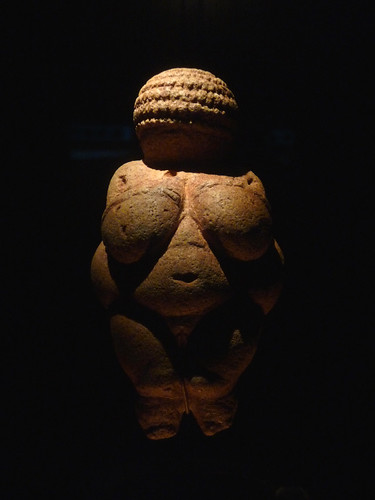
(Photo Credit: Flickr)
Venus of Willendorf (Wiki-Link)
I spent some time today, reading posts here, which led me to explore the topic of Fat Positivity. My online search culminated in reading about Venus of Willendorf, an stone age female figurine, which was found back in August of 1908, at an paleolithic excavation site near Willendorf, an small village in Lower Austria, near the town of Krems. The figurine was sculpted from Oolitic Limestone, and it is estimated to belong to the time period between 28,000 BCE to 25,000 BCE; but upon later examination, archaeologists believe the core of limestone it came from dates back to 30K years before the figurine's discovery.
To me, she's beautiful. She represents a period of time when there was no mirrors to examine one's physical appearance, yet it's speculated that pools of water was the only way anyone could know what their body's looked like.
Keeping in mind, questions posed by Nycfem, in an prior post in this thread (years ago), I examined the text provided in the wiki-link article, for ideas surrounding fat shaming or phrases of thought revealing shame about the notion of being fat. It's hard to know the gender of the person who created the article on Wiki; but I thought it was an positive sign that one of the curators of the stone age sculpture was female: Catherine McCroid. McCroid hypothesized that figurines, such as this one in particular, was created as an "self portrait" made by women from that time period.
As for fat shaming rhetoric posed by either people in our lives or via things we see in print or by things we observe other's say about women who are fat? I can say that for most of my life, I've been told that I'm morbidly obese, that my fat will kill me, that I'm not beautiful, that if I were not fat, I'd be beautiful.
I say to myself that I'm beautiful. I know that I am beautiful because I choose to cultivate all the qualities and traits I possess to be as beautiful as they can be.... even if by other's standards my idea of beautiful is not beautiful to them. I think what matters the most to me is that although I will never be skinny, and although I may lose some weight, that my fat body is as beautiful as it can be, from the top of my head to the bottom of my feet and end of my toes. I'm kissable. I'm squishy. I'm loveable and valuable as an fat woman. I am the portrait of my own beauty.
Venus of Willendorf inspires me as much as all my sisters in the community.
I believe we are beautiful as we are and I celebrate being fat as a positive sign of our collective self acceptance and unconditional love for the state of existence each one of us experience in our lives every day.
Sending Femme Sister love to all,
Kätzchen
